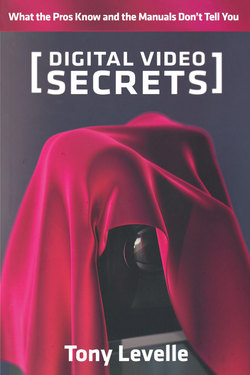Читать книгу Digital Video Secrets - Tony Levelle - Страница 12
На сайте Литреса книга снята с продажи.
ОглавлениеCHAPTER 4
SUPPORTING AND MOVING THE CAMERA
How you support and move the camera is important.
Secret 17: Use a Tripod
Secret 18: Use a Tilt
Secret 19: Use a Pan
Secret 20: Shoot hand-held
Secret 21: Use a Dolly
Secret 22: Use a Jib
Hand-held cameras, when used correctly, can give you marvelous footage that you can’t get any other way. In the documentary War Tapes, director Deborah Scranton gave small Sony camcorders to three soldiers in a National Guard unit from New Hampshire just before their unit was deployed to Iraq. The resulting hand-held footage is powerful and emotionally moving. The technical quality of the images was good enough that the resulting digital footage (along with footage from a larger DV camera that Scranton used for interviews) was successfully transferred to 35mm film for the film’s theatrical release.
Most of the time, however, hand-holding simply doesn’t work. Shooting without a tripod often results in “jiggle cam” or even worse, “vomit cam.”
This cliché was exploited to great effect in the pseudo-documentary Blair Witch Project. The movie was shot hand-held, and the camera jiggled and swerved, just like the shaky, hand-held shots of an amateur. The effect was so powerful that some teenagers who saw the movie thought that it was actual documentary footage.
In reality the movie was made by two extremely talented and skilled filmmakers who deliberately used this style to create believability.
If you remember only three words about camera movement, let them be these: use a tripod.
Placing the camera on a tripod and locking it down before each shot is a perfectly acceptable way to shoot your film.
SECRET 17: USE A TRIPOD
The standard advice for buying a tripod is “Get the best tripod you can afford.” Think of your tripod as an investment in your shooting career.
A good tripod will improve your shooting. It will be easier to set up, and you will be able to level the camera quickly. Shots where you use the tripod will be rock-solid and pans and tilts will be smooth and level.
Professional tripods have a bubble on the “head” (the part that holds the camera) to tell you when the tripod head is level. The best tripods have a “ball” mount so you can quickly level your camera. With a ball mount, you don’t have to constantly adjust the tripod legs to level the camera. You just set up the tripod legs, loosen the ball and swivel the tripod head to level the camera. When the camera is level, simply re-tighten the ball mount.
Heads are interchangeable on high-end tripods. Once you buy the “sticks” (tripod legs) you can buy new heads to accommodate different size cameras. Heads are usually rated by camera weight. The Miller Solo series, for example, has heads designed for five-, ten- and twenty-pound cameras.
When you buy a tripod, buy one that is rated one step heavier than the camera you plan to use. That gives you the latitude to upgrade to a larger camera or hang accessories, like heavy batteries and camera lights, on your existing camera.
Paradoxically, the lighter your camera, the heavier you want your tripod (within reason). When you attach a heavy tripod to the camera, the weight of the tripod helps steady the camera.
Many cameras also have OIS (Optical Image Stabilization) to help stabilize the camera. Modern OIS is amazing; it can smooth out “jiggly” hand-held images and give you brilliant footage. However, the best solution for rock-solid shooting—in most situations—is a good tripod.
When you mount the camera on a tripod, turn the camera’s OIS “off.” Otherwise, the OIS may “fight” the camera movement when you pan or tilt. This will show up as a slight “jump” in the image when the pan or tilt stops.
Filmmakers are vehement in their defense and preference for tripod brands. Try several at your local camera store, and find out which one appeals to you.
SECRET 18: USE A TILT
